Geeks’ Picnic
I went to LinuxWorld in San Francisco last month. A few highlights:
Welcomed our new robotic overlords
 Print This Post
Print This Post
I went to LinuxWorld in San Francisco last month. A few highlights:
Welcomed our new robotic overlords
 Print This Post
Print This Post
I’m sorry. I just can’t take it any more. I’m going to stop the world and get off. Yes, that’ll make the oceans slosh and drown everyone else. You should have thought of that before you bored me.
Okay, you ask. What is it now?
Drivel framed in drivel. (No, I don’t have a link to the original. I can’t be arsed. It’s in the Proceedings of the National Academy of Science.) Study: men with genetic variant struggle with commitment Or this one from the New Scientist: Monogamy gene found in people
What if you could tell whether a man is husband material just by peering at his genes?
 Print This Post
Print This Post
Your Blogscientist has been falling down on the job. A few days ago I saw plenty of headlines about new nanoscale batteries. Everything’s nano-whatnot these days. I figured I’d read about it later. No doubt somebody had an extra 5% improved energy yield or something.
Turns out, no, this is really new. A team at MIT has genetically engineered bacteriophages — a kind of virus that normally attacks bacteria — to assemble batteries. Put them in a soup with the right ingredients and they pull out what they need to assemble anodes, cathodes, and, in short, batteries. (Abstract of Proceedings of National Academy of Sciences article.)

It’s lab bench work at this point, but as Belcher says,
“[R]ight now the thing is trying to make the best material possible, and if we get a really great material, then we have to think about how do you scale it.”
Scaling up means laptop batteries, car batteries, and — shoot for the stars, any damn fool can hit the ground — electromagnetic rail gun spaceship launching batteries.
Technorati Tags: batteries, nanoscale, virus, Belcher, Hammond, Chiang, MIT
 Print This Post
Print This Post
Via Slashdot I found this Science News article which links to a mathematics site that’ll blow your mind up like bubble gum. It’s visualizations by mathematicians and graphic artists of four- and more-dimensional shapes. Plus, if you have any mathematical ability, in other words if you’re not like me, you may even understand what they’re talking about. But understanding isn’t needed to feel your mind expand.
Read more »
 Print This Post
Print This Post
My issue of the Royal Horticultural Society Garden magazine arrived today, and the first thing I saw was:
Competitive gooseberry growing in northwest England has a long and distinguished history.
With a blurb like that, how could I not read the article? (Web version, which differs from the print one.) So I learned that growing the gooseberry supreme requires “pens” where the bushes can be protected from birds, shaded from excessive sun (In northwest England? You’re kidding me, right?), as well as excess rain which can burst the fruit. In the old days, a rhubarb leaf was inverted over the bush. I’ll dream tonight of shy gooseberry plants, peering out from under their peaked rhubarb leaf hats.
But I jest. Competitive gooseberrying is serious business. Follow me closely here.
The bushes must be carefully pruned like rose trees, and the crown of branches trained flat, like an umbrella, so that the berries hang down. Otherwise wind might blow the prize heavy berry onto the thickly thorn-covered branches of the bush. The berry would burst, and there you’d be at the next meeting of the gooseberry club with nothing to show for all your trouble.
Once a year, in late July or early August, everything must be in readiness for the “getter,” who witnesses the picking of the competition berries, their careful placement in boxes padded with cotton wool, and who seals the box so that no cheating with some kind of ersatz substituted berry can occur. (I think Ohio needs to get a gooseberry club to come and oversee the vote in November.)
Keeping the few prize berries in perfect condition on the tree until the getter arrives is one of the difficult tasks in a devoted gooseberry grower’s life. Months of concentration, watering, shading, and timing go to produce the perfect berry at exactly the week and the day when the judging takes place. That’s why, like migrating swifts who miss the one day the mayflies hatch, the growers are upset about this:
Kelvin [the current prize-holder] feels the gooseberry season is becoming earlier: “You can get them huge a week or so before — the challenge is to keep them intact on the tree until the getting.”
The trees are feeling the heat, and so are the gooseberry societies. They’re talking of moving their shows forward. Gooseberry judging dates: the new measure of global warming. And you thought I was joking when I said it was a serious business.
Technorati Tags: gooseberries, global warming
 Print This Post
Print This Post
This is another story in the category of “We’re from the government. We’re here to help.” The reporting makes me want to bang my head against the desk, but I can’t because I’m writing this from a lawn chair in my back garden. All the stories stress how safe the process is. That is not the point. Not . . . the . . . point.
FDA to allow radiation of spinach and lettuce
Health regulators have approved the use of ionizing radiation for fresh spinach and lettuce, saying the technique already approved for other foods [ can help control harmful bacteria and other pathogens.
The Food and Drug Administration said on Thursday the radiation treatment also would make the leafy greens last longer and give them greater “shelf-life” for retailers and consumers.
The problem is not –not!– that radiation turns the lettuce into a Green Monster or that is leaves horrible radiation cooties all over the leaves.
The problem is that irradiating food is the equivalent of leaving it out in the sun for a few days. It destroys vitamins and lowers the nutritional value generally.
That is not good. I mean, you’re eating spinach because it’s good for you, for chrissakes. You’re not just trying to ingest a water-based form of greenish tissue paper.
The other problem is that by more or less sterilizing the surface, a host of bad farming practices can be covered up. Some of those bad practices, such as poor harvesting methods or taking longer to get the product to market, also lower nutritional value.
At least they are talking about labelling treated products.
Spinach and lettuce that have been irradiated will have to carry a special “radura” logo and state the product has been “treated with radiation” or “treated by irradiation,” FDA’s Kwisnek said.
I guess farmers have less clout than Monsanto and their ilk who have successfully kept everyone in the dark about which foods have genetically engineered traits, and what those are. I was, am, and always will be livid that I can’t boycott Round-Up resistant junk — or “Round-Up Ready” as they like to call it.
Technorati Tags: food, radiation, bacteria, FDA
 Print This Post
Print This Post
The annoying thing about all the clean energy technologies is that we can’t buy them and use them. Breakthroughs keep being reported, and then . . . nothing. If I had a solution to that problem, I’d be a lot richer than I am, but I’m a dreamer like everyone else. So, just to give you some more things to dream about, here are three advances on the energy front. (Life happened, so this is a few weeks past due, as usual for me.)
First is the discovery of how to channel light so that any window can act as a solar collector. Channeling light has been done since the first days of fiberoptics, and collecting light is the big problem facing photovoltaics. So it seems like somebody should have done this decades ago. As it happens, they tried in the 1970s. But there were no materials at the time capable of efficiently channeling light in the precise way required, nor did we have the right light-absorbing dyes. Materials scientists are the unsung heroes of the tech world.
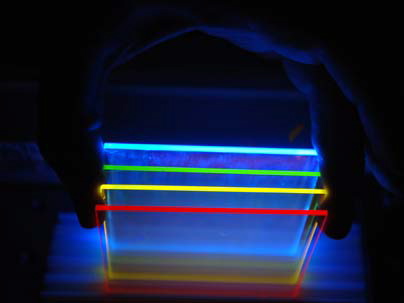 (Photo / Donna Coveney) Read more »
(Photo / Donna Coveney) Read more »
 Print This Post
Print This Post
BBC headline this morning: Bush condemns ‘bullying’ Russia
Iraqis could not be reached for comment. The spokesman was stuck in a traffic jam caused by yet another new checkpoint.
Technorati Tags: Bush, Russia, Georgia, Iraq, bullies
 Print This Post
Print This Post
Interesting times. From universetoday.com (via Slashdot):
The White House is Briefed: Phoenix About to Announce “Potential For Life” on Mars
It would appear that the US President has been briefed by Phoenix scientists about the discovery of something more “provocative” than the discovery of water existing on the Martian surface. … Whilst NASA scientists are not claiming that life once existed on the Red Planet’s surface, new data appears to indicate the “potential for life” more conclusively than the TEGA water results. Apparently these new results are being kept under wraps until further, more detailed analysis can be carried out….These new MECA results are, according to the Phoenix team, a little more complex than the water “discovery.” Scientists are keen to point out however, that this secretive news will in no way indicate the existence of life (past or present) on Mars; Phoenix simply is not equipped make this discovery. What it can do is test the Mars soil for compounds suitable to support life. The MECA instrument does have microscopes capable of resolving bacterial-scale life forms however, but this is not the focus of the forthcoming announcement, sources say.
They seem a bit desperate not to find evidence of life. Mustn’t upset anyone entitled to their own facts, I guess.
The likeliest scenario is that this will turn out to be evidence of some carbon-based compounds. That, together with the earlier evidence that the Martian soil at the Phoenix site has water and Earth-like pH all points toward increased probability that there was or is life on Mars.
It’s bacterial life, at most, but that would be huge. Vast. Impossible to overstate. Because it means one of two things: either that life generally appears when there is carbon-based chemistry in the presence of water, or that some bacteria can make it through space often enough to seed life wherever conditions support it. Or both.
Either way, it would mean that life is common in the universe, not rare.
Technorati Tags: Mars, Phoenix, water, life
 Print This Post
Print This Post
The statistics show that there was unfunny business in recent elections. They show it far past scientific levels of certainty. The statistical likelihood of fraud (“nonrandom events” in statspeak) is billions to one. (Links to the original research here.) But what keeps too many of us looking the other way — we’re not some backward Berzerki republic, for God’s sake! — is that not enough culprits have been nabbed in the act.
Well, the plot thickens. From The Raw Story
The first red flag went up when the computer patch was installed in person by Diebold CEO Bob Urosevich, who flew in from Texas and applied it in just two counties, DeKalb and Fulton, both Democratic strongholds. . . .
The whistleblower said another flag went up when it became apparent that the patch installed by Urosevich had failed to fix a problem with the computer clock, which employees from Diebold and the Georgia Secretary of State’s office had been told the patch was designed specifically to address.
Some critics of electronic voting raised questions about the 2002 Georgia race even at the time. Incumbent Democratic Sen. Max Cleland, who was five percentage points ahead of Republican challenger Saxby Chambliss in polls taken a week before the vote, lost 53% to 46%. Incumbent Democratic Governor Roy Barnes, who led challenger Sonny Perdue in the polls by eleven points, lost 51% to 46%. However, because the Diebold machines used throughout the state provided no paper trail, it was impossible to ask for a recount in either case. . . .
[The security expert] took the evidence to the Cyber-Security Division of the Department of Justice and reported the series of events to authorities. The Justice Department has not yet acted on his report.
As Alice said, “Curiouser and curiouser.”
Technorati Tags: election, tampering, Diebold
 Print This Post
Print This Post
I was at the Santa Barbara Orchid Fair last weekend. (It’s a tough job, but somebody’s got to do it.) One of the huge growers there, SB Orchid Estates does an open house at the same time. This striking species caught my eye:
And this one:
The Central and South American Stanhopea and Catasetum orchids produce what amounts to perfume used by male euglossine bees to communicate with female euglossine bees. Everybody wins. The orchids get highly specific pollinators who find them from, literally, miles away. And they get that at very little cost in terms of the energy it takes to produce a few pheromones. The male bees don’t have to make their own. And the females get attractive males.
The euglossines are on the spectacular side themselves:
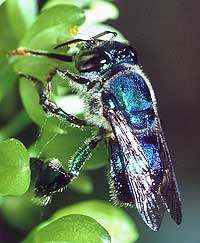
Euglossa viridis, photo: Benjamin Bembe
Technorati Tags: orchids, Platystele, Stanhopea, euglossine bees
 Print This Post
Print This Post
I have birds. I use newspapers to line the bird cages. However, I haven’t bought a newspaper since November of 2004. It’s too depressing. So I’m getting to the bottom of the stack that was going to be recycled when I realized I better save it. Who knew when the world would be in a fit condition to provide not-sick-making bird cage liners?
So I bumped into these mortgage ads from my corner of Southern California in the heady days of 2003 . . .
[click on image for larger size]

The circled “No Tax Return” promises that this lender won’t want to see any real evidence of income. It translates to, “Please come and lie to us so that we can get loan origination fees off you! Puhleeeze!”
This wasn’t unusual. Au contraire. A couple more ads from the same page of Aug. 17, 2003 classified ads in the Real Estate section of the Ventura County Star:

Technorati Tags: housing, boom, 2003
 Print This Post
Print This Post
This time it really is a Friday, but the picture isn’t a photo, no matter how much it looks like one. It’s one of Kees Veenenbos’s amazing renderings of other worlds based on the available data from space flights. His work has appeared in National Geographic (print edition ). Go to Veenenbos’s site and lose yourself.
To give you an idea of what you’ll be missing if you don’t go, here’s a picture of Jupiter’s icy moon, Europa, based on data from the Voyager Imaging Team. [Update, 2009-09-27: not currently posted on that site.]

space, art, Veenenbos
 Print This Post
Print This Post
I think this should be a motivational poster. You know, the kind with captions like “Determination,” and “Perseverance,” and “Achieve Your Goals.” This one should be: “Energy Conservation.”
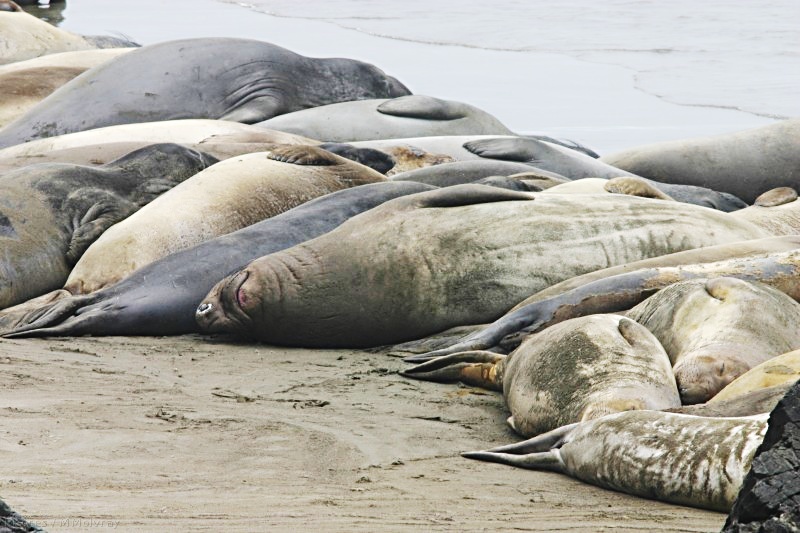
The elephant seals are working hard, regenerating all-new skin. It’s called a catastrophic molt and it takes several weeks. When molting, they’re too susceptible to the cold to go into the water, so they don’t feed or drink during those weeks. They spend the whole time conserving energy. (More info at Wikipedia.) The photo was taken at–logically enough–Seal Beach on California’s Central Coast.
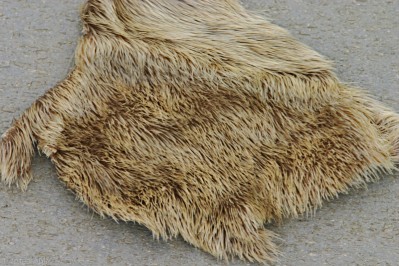 |
The fur side of a piece of molted skin found lying on the beach. |
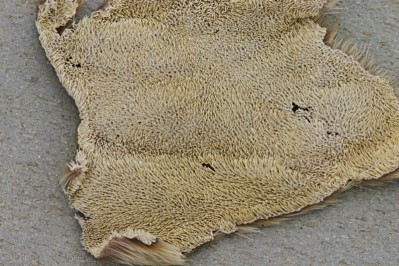 |
The once-living side of the skin. |
Technorati Tags: elephant seals, molt, Seal Beach
 Print This Post
Print This Post
Photovoltaics do take energy to make and use toxic elements that can cause nasty pollution unless they’re contained. We knew that. But what I didn’t really bother to think about is that those same rare elements that are toxic are also, well, rare. We’re using them like they’re not rare. So . . . doh! . . . they’ll run out soon. Meaning soon. Times like “five years” and “2017” come out of the number-crunchers.
From New Scientist, reporting on Gordon, Bertram, and Graedel’s recent paper (abstract, pdf).
It’s not just the world’s platinum that is being used up at an alarming rate. The same goes for many other rare metals such as indium, which is being consumed in unprecedented quantities for making LCDs for flat-screen TVs, and the tantalum needed to make compact electronic devices like cellphones. . . . Even reserves of such commonplace elements as zinc, copper, nickel . . . will run out in the not-too-distant future. . . . [T]he metal gallium, which along with indium is used to make indium gallium arsenide . . . is the semiconducting material at the heart of a new generation of solar cells . . . . Reserves of both metals are disputed, but . . . René Kleijn, a chemist at Leiden University in the Netherlands, . . . estimates gallium and indium will probably contribute to less than 1 per cent of all future solar cells – a limitation imposed purely by a lack of raw material.
Iridium is the material that blankets the planet in a thin layer, left over from the asteroid strike that bothered the dinosaurs. Some of the other elements are found in sand in nano-quantities. However, grinding up the whole planet to make solar panels doesn’t seem like a much better idea than turning it inside out to burn it.
Time to get extremely serious about organic (in the sense of carbon-based) photovoltaics. It’s complicated, though. To begin with, organic molecules break down easily. And then, as Terry Pratchett might say, it’s quantum. However, plants do it. Bacteria do it. You’re not going to tell me we’re stupider than plants, are you? (Don’t answer that.)
Technorati Tags: solar power, photovoltaic, PV, gallium, resources, shortage, Graedel
 Print This Post
Print This Post
I keep wanting to do something with pictures, and I keep procrastinating dreadfully. But just because I drop the ball all the time is no reason not to pick up again. If I didn’t, I wouldn’t have anything to drop, would I?
This is a close-up of Dracula venefica taken at the Leiden Botanical Garden in 2000. (A bit more on Dracula at — where else? — Wikipedia.) It’s a small plant that grows in the Colombian Andes. The little “face” is smaller than a centimeter.

Technorati Tags: orchids, Colombia, Dracula venefica
 Print This Post
Print This Post